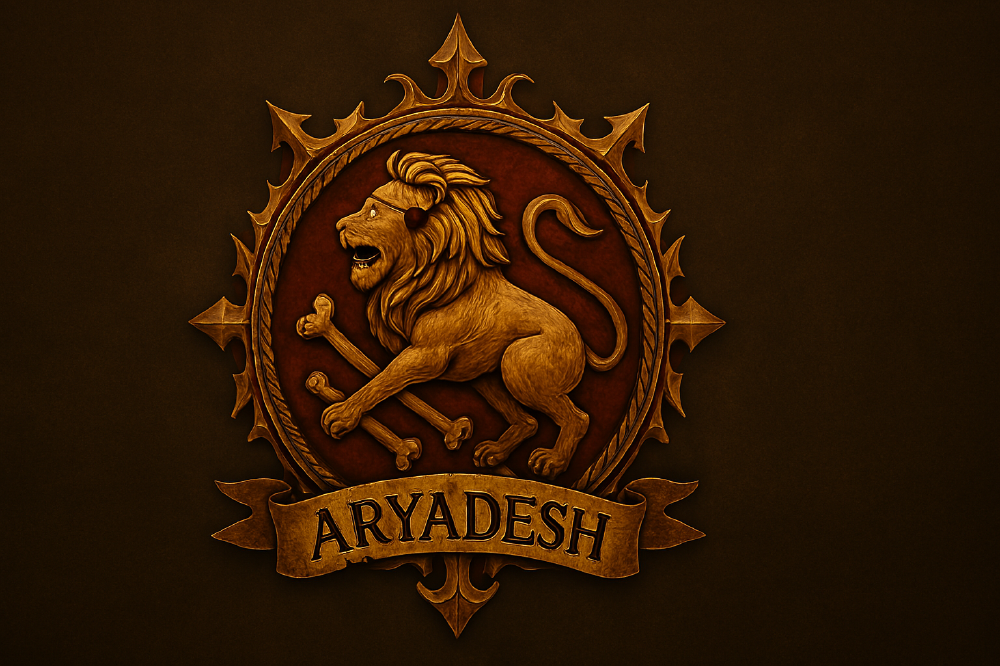| National Factbook |
| Flag: |

|
| Nation Name: |
Aryadesh |
| Leader Name: |
Ashok |
| Currency: |

Dollar |
| National Animal: |

Asiatic Lion |
| History: |
Ashok Land was officially formed after the historic merger of two prosperous and culturally significant states. Punjab, known for its rich cultural heritage and agricultural prowess, and Haryana, famed for its industrial and rural balance, decided to unite under a visionary agreement aimed at enhancing regional strength and development. The merger symbolizes the unity of two powerful regions to create a new identity while retaining their shared history of resilience, tradition, and progress. This Union emphasizes both states' commitments to growing stronger together and enhancing economic prosperity through strategic cooperation. |
| Geography |
| Continent: |
Asia |
| Land Area: |
124,321.52 sq. km |
| Terrain: |
The Union’s terrain is primarily composed of fertile plains with large agricultural lands that define much of the region. The area is crisscrossed by major rivers such as the Sutlej and Yamuna, providing vital irrigation for its renowned agricultural sector. There are also rolling hills, particularly in the northeastern parts near the Shivalik range, and flatlands stretching towards the southwest. The fertile soil, combined with a well-established canal network, makes the Union one of the most productive agricultural zones in India. |
| Highest Peak: |
Mt. Morni,
1,267 meters
|
| Lowest Valley: |
Punjab Basin,
210 meters
|
| Climate: |
The Union experiences a subtropical climate, with hot summers, a monsoon season, and relatively cool winters. Summers are typically long and hot, with temperatures often exceeding 40°C (104°F), while the monsoon season brings much-needed rain to the agricultural lands. Winters are mild, with temperatures ranging between 5°C (41°F) and 20°C (68°F), making it favorable for wheat and other rabi crops. Overall, the climate is well-suited for agriculture, with ample water resources from monsoons and river systems. |
| People & Society |
| Population: |
2,903,397 people |
| Demonym: |
Bharatiya |
| Demonym Plural: |
Bharatiya |
| Ethnic Groups: |
Punjabi - 60.0%
Haryanvi - 35.0%
Other Bharatiya Groups - 5.0% |
| Languages: |
Punjabi - 55.0%
Haryanvi - 35.0%
Hindi - 10.0% |
| Religions: |
Hinduism - 55.0%
Sikhism - 40.0%
Other Religions - 5.0% |
| Health |
| Life Expectancy: |
74 years |
| Obesity: |
18% |
| Alcohol Users: |
25% |
| Tobacco Users: |
12% |
| Cannabis Users: |
5% |
| Hard Drug Users: |
2% |
| Economy |
| Description: |
The Union of Punjab and Haryana operates under a mixed economy with a strong focus on both agriculture and industry. Punjab, known as the “Granary of India,” leads in wheat, rice, and dairy production, while Haryana excels in industrial sectors such as automobile manufacturing, information technology, and textile production. The economy thrives on a balanced combination of rural and urban development, with robust infrastructure connecting major cities and rural areas. The Union's economy is driven by both public and private investments, emphasizing sustainable development and modernization.
|
| Average Yearly Income: |
$78.57 |
| Gross Domestic Product (GDP): |
$1,598,641,651.00 |
| GDP per Capita: |
$550.61 |
| Gross National Income (GNI): |
$739,871,425.00 |
| Industries: |
The Union's major industries include agriculture (rice, wheat, dairy, sugarcane), manufacturing (automobiles, textiles, electronics), and services (information technology, trade, and logistics). Tourism is also a growing sector, with visitors drawn to the cultural heritage of Punjab and the industrial and rural blend of Haryana. There is significant investment in green energy and infrastructure development as the Union seeks to modernize its economy further. |
| Military |
| History: |
The armed forces of the Ashok Land were established shortly after the historic merger of the two states. Combining the strengths of both regions, the Union's military is built on the principles of national security, territorial integrity, and defense modernization. Punjab, with its long history of martial traditions, has provided a strong foundation of disciplined soldiers, while Haryana, known for its contribution of personnel to India's armed forces, brings a robust and experienced military culture.
The Union military is organized into three main branches: the Army, Navy, and Air Force, all operating under a unified command structure that emphasizes rapid response, defense of critical infrastructure, and border security. The Army is the largest branch, with significant capabilities in ground combat, logistics, and artillery, drawing from Punjab's rich history of land defense and Haryana's experience in modern military tactics.
The Navy, though relatively smaller, plays a critical role in securing the rivers and inland waterways that cross through both states. It also focuses on the protection of the Union’s trade routes and defense of its water-based infrastructure. The Air Force, on the other hand, has been growing steadily, emphasizing air superiority, reconnaissance, and close air support for ground forces. Advanced training programs and modern aircraft acquisitions are part of the Union’s strategy to build an agile and technologically advanced air fleet.
While the military of Punjab-Haryana Union is designed for defense and deterrence, it has also adopted a focus on peacekeeping operations and regional stability. The Union has strong partnerships with neighboring states and maintains a firm stance on diplomatic resolutions to conflicts. Special units have been formed for disaster relief, humanitarian missions, and counterterrorism, showcasing the military’s adaptability in times of crisis.
Through continuous modernization efforts and strategic partnerships, the Union aims to build a future-ready military force that not only safeguards its borders but also contributes positively to international peace and stability. |
| Soldiers: |
345,000 |
| Tanks: |
0 |
| Aircraft: |
40 |
| Ships: |
49 |
| Missiles: |
0 |
| Nuclear Weapons: |
0 |
| Last Updated: 09/26/2024 01:47 pm |














